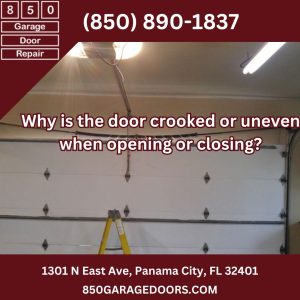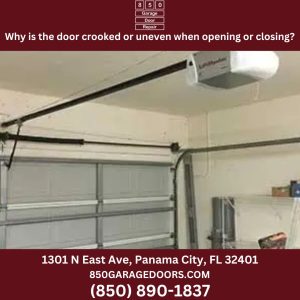What crooked means and why it is risky
Common symptoms at a glance
- One side of the door hangs lower during movement
- The bottom seal touches the floor on one side before the other
- Rollers scrape or pop out of the track
- Door shudders, squeals, or pauses while moving
- Opener strains, buzzes, or stops and reverses
Safety risks of running an uneven door
A crooked door can pull hardware out of alignment, shear cable strands, and overload the opener. That can damage panels and increase the chance of a cable jumping the drum or a spring breaking under uneven stress. The door is one of the heaviest moving parts in the house so keeping it level protects people, pets, and vehicles.
How a garage door stays level in plain English
Springs cables rollers and tracks and who does what
Springs carry most of the door weight so the opener only guides movement. Lift cables connect the bottom brackets to the drums that wind evenly to keep both sides in sync. Rollers guide the door through the tracks which hold everything straight. If any piece loses strength or position the door tilts.
Balance versus opener power and why the opener can mask problems
When the door is balanced you can lift it by hand with moderate effort and it will stay about waist height when you release. An opener may still move an unbalanced door but it will work harder, which hides the real issue for a while and adds wear to gears and safety systems.
Top causes of a crooked or uneven door
Broken or weakened springs
Signs your torsion or extension spring is failing
- Gap in a torsion spring or a stretched extension spring
- Door feels very heavy during manual lift
- Loud snap heard from the garage followed by a door that will not open
Important safety note about spring tension
Springs are under significant tension. Adjusting or removing them without proper tools and training can cause severe injury. Leave spring work to a qualified technician.
Frayed stretched or off spool lift cables
How cables make one side lag
If a cable loses strands, stretches, or jumps off its drum, that side of the door drops slightly and the door goes out of level. Rust from coastal air in the Florida Panhandle can accelerate cable wear, especially when sand and moisture collect near the bottom bracket.
Bent loose or misaligned tracks
Track brackets and fasteners that work loose
Vibration and regular use can loosen track brackets. If the track flares out or shifts inward the rollers bind and the door tilts. After tropical weather, fasteners can loosen as wood framing swells and dries, which changes the track position.
Worn or seized rollers and hinges
Flat spotted nylon rollers and dry metal rollers
Rollers that do not spin smoothly will slide instead of roll. That drags one side of the door and makes the opener pull unevenly. Corrosion on metal rollers from salt air is common near the Gulf coast.
Door panel damage or missing struts
When the door itself is no longer straight
Impact from a vehicle bumper or a strong wind gust can bow a panel. Without a reinforcing strut a long span door can flex, which changes how weight transfers to the tracks and causes tilt.
Opener issues limits or force settings masking balance problems
Why recalibrating is not a fix for a heavy or tilted door
Adjusting travel or force may let the opener move the door, but it does not restore balance. The underlying mechanical issue will continue to cause wear and can trigger safety reversals.
Obstructions in the track debris hardware weatherstrip
Small objects that cause big tilts
A screw that backed out or a bit of broken roller can catch a wheel and hold one side back. In Florida, blown in sand or a swollen weatherstrip after a storm can become the unexpected stop that tips the door.
Quick diagnostics you can do with no special tools
Five minute visual check from the ground
Look for these red flags on cables springs rollers tracks
- Frayed cable strands or a cable riding against the drum flange
- Rollers that do not spin freely or sit at an odd angle
- Shiny rub marks on tracks that show binding points
- Loose or missing track bracket bolts
- Gaps in torsion springs or stretched extension springs
Balance test with the opener disconnected
Simple step by step to spot imbalance
- Close the door fully and pull the emergency release cord so the opener trolley is free
- Lift the door by hand to about knee height then waist height then shoulder height
- At each point let go carefully and watch Does it stay in place rise or fall
- If it slams shut or drifts strongly the door is out of balance
Photo eye myth busting
Why misaligned sensors do not usually cause a crooked door
Photo eyes only tell the opener whether the path is clear. If they are misaligned the opener will not close at all or will reverse. They do not create tilt. A door that is moving unevenly has a balance or track issue.
When to stop and call a pro immediately
- A cable is off the drum or badly frayed
- A spring is broken or you see a gap in the coil
- The door is stuck partially open and leaning
- Rollers have popped out of the track
- The opener tries then stops repeatedly with a tilted door
One look table quick cause and action guide
| Likely cause | What a homeowner can do safely |
|---|---|
| Frayed or off spool cable | Do not operate the door Secure the opening and contact a technician |
| Weakened or broken spring | Avoid manual lifting Leave spring service to a professional |
| Loose or misaligned track | Tighten accessible bracket fasteners gently from the ground if safe Then schedule service |
| Worn rollers or hinges | Apply a small amount of garage rated lubricant to roller bearings and hinges Avoid the tracks |
| Opener settings compensating for a heavy door | Return settings to factory defaults only after a mechanical inspection |
What you can do yourself versus what needs a pro
Safe DIY tasks
- Tighten hinge and track bracket hardware that you can reach safely
- Clean the inside faces of tracks with a dry cloth to remove dust and grit
- Lubricate rollers hinges and springs with a garage specific product Use a small amount and wipe excess
- Test the door balance after disconnecting the opener
- Keep the bottom seal and weatherstrip clean so it seats evenly
Pro only repairs
- Spring replacement or adjustment
- Cable replacement or drum realignment
- Track replacement or full realignment when components are bent
- Panel reinforcement with struts or replacement after impact
- Opener gear and rail service after a period of strain
Fixes and typical cost ranges ballparks
Every garage is different and materials can vary between steel wood and composite construction. Coastal exposure and door size also change the scope of work. For that reason this guide focuses on the work itself rather than prices. Expect a technician to inspect the full system recommend the safest repair and confirm the parts required. If a spring has failed both springs are often replaced together to keep lift even. Cables are replaced in matched pairs along with any damaged drums or bottom brackets. Track work may involve straightening and securing or full replacement when bent. Roller and hinge service can include upgraded rollers for smoother travel. Opener recalibration should only happen after mechanical issues are corrected so safety settings reflect a balanced door.
Prevent it from happening again
Seasonal maintenance checklist
- Tighten visible hinge and track bracket fasteners
- Inspect cables for rust or fraying at the bottom brackets
- Wipe inside faces of tracks clean to remove grit
- Test balance with the opener disconnected
- Look for panel bowing and confirm struts are intact
Lubrication guide what to lube and what not to
- Lubricate roller bearings hinges and spring coils lightly
- Do not lubricate the track running surfaces They should stay clean and dry
- Wipe off drips to avoid attracting sand and dust common in coastal Florida
- Refresh lubricant after heavy storms or long humid periods
Service intervals when to schedule a tune up
In the Florida Panhandle consider a professional inspection once a year due to salt air and humidity. After a major storm schedule a quick check to catch corrosion or loosened hardware early. Homes near the coast may need more frequent attention because metal components can corrode faster.
FAQs
Is it safe to keep operating a crooked garage door
No. Continued use increases stress on cables tracks rollers and the opener. Stop use when you see obvious tilt and schedule an inspection.
Why is the door more uneven during humid or rainy weather
Moisture can swell wooden framing and the bottom weatherstrip which tightens the fit on one side. Humidity also reduces lubrication life and encourages surface rust on cables and rollers. These changes make small alignment issues more noticeable.
Can an uneven door affect security or fire safety
Yes. A tilted door may not seal at the floor which invites pests and water. In an emergency an out of balance door can be harder to lift manually which slows evacuation.
Do I have to replace both springs if only one broke
Most professional repairs include replacing both springs so the pair shares load evenly. Replacing one often leaves the system unbalanced and can shorten the life of the remaining spring.
Related problems and fixes
Door will not open all the way
Possible causes include travel settings that are too short a damaged panel that binds or a weak spring. Inspect for visible damage and have a technician measure spring strength and opener travel.
Door slams shut
That points to a serious loss of counterbalance from a broken spring or a cable off the drum. Do not attempt manual lifting. Call for service.
Opener hums but does not lift
The opener may be fine while the door is too heavy due to a broken spring seized rollers or a jammed track. Disconnect the opener and test the door by hand. If it is very heavy stop and schedule repair.
Glossary
Torsion spring
A spring mounted above the door that turns a shaft to lift evenly across the opening.
Lift cable
A cable that connects the bottom of the door to a drum which winds to raise the door.
Bearing plate
A support at the end of the torsion shaft that holds a bearing so the shaft turns smoothly.
Strut
A metal reinforcement that stiffens a door panel to prevent bowing and to keep the door straight.
Wrap up and next steps
A crooked garage door usually traces back to balance or path of travel. Springs carry weight cables keep both sides in sync tracks and rollers guide the movement and the opener only helps. When any one part is worn loose or obstructed the door tilts which accelerates wear and raises safety risks. If your garage door looks uneven follow the simple checks above then pause operation if you see frayed cables broken springs bent tracks or strong tilt. The safest path is a full system inspection by a trained technician who can restore balance and confirm all safety features work.
If you are in the Florida Panhandle and want experienced help you can reach out to 850 Garage Doors. Visit the company website at www dot 850garagedoors.com to learn more about service options and scheduling.



